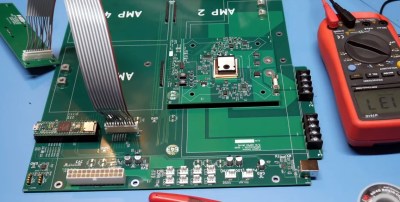At first glance, you might think the piece of hardware pictured here is a modern gaming computer. It’s got water cooling, RGB LED lighting, and an ATX power supply, all of which happen to be mounted inside a flashy computer case complete with a clear window. In truth, it’s hard to see it as anything but a gaming PC.
In actuality, it’s an incredible custom electronic load that [EE for Everyone] has been developing over the last four months that’s been specifically designed to take advantage of all the cheap hardware out there intended for high-performance computers. After all, why scratch build a water cooling system or enclosure when there’s such a wide array of ready-made ones available online?

Inside that fancy case is a large PCB taking the place of the original motherboard, to which four electronic load modules slot into. Each of these loads is designed to accept a standard Intel CPU cooler, be it the traditional heatsink and fan, or a water block for liquid cooling. With the current system installed [EE for Everyone] can push the individual modules up to 275 watts before the temperatures rise to unacceptable levels, though he’s hoping to push that a little higher with some future tweaks.
So what’s the end game here? Are we all expected to have a massive RGB-lit electronic load hidden under the bench? Not exactly. All of this has been part of an effort to design a highly accurate electronic load for the hobbyist which [EE for Everyone] refers to as the “Community Edition” of the project. Those smaller loads will be derived from the individual modules being used in this larger testing rig.
We’ve actually seen DIY liquid cooled electronic loads in the past, though this one certainly sets the bar quite a bit higher. For those with more meager requirements, you might consider flashing a cheap imported electronic load with an open source firmware to wring out some extra functionality.
[Thanks to Zane for the tip.]















First time I read this term “electronic load”. After googling what that is I still don’t understand what this project wants to accomplish.
It is a dummy load, but for DC. It is useful for example to test a power supply.
Dodo, its much more than a dummy load. Load transients, steps, etc – Very necessary for validating many aspects of an electrical design.
I’m not entirely sure but I saw a video of a guy with a Tesla gun and the power supply looked like a RGB gaming PC with water cooling. I think it might be ghat
It’s basically a device that wastes a lot of (precisely calculated) energy. There’s probably a joke in there about a gaming rig already being a good way to burn up ba few hundred watts, but this actually allows you to dial it in.
I deal with load tests on UPS’s and CRAC units in datacenters… In that environment you NEED to know that your power supply can deal with the draw AND that your cooling can keep up at peak loads. But that’s completely out of the scale of a small project like this.
This smaller scale one, I could see being used for testing smaller power circuits til failure.
If you get involved with EE even a little bit, you will understand. Critical tool. Use one all the time. Even more useful: Four quadrant power supply. Operates in all 4 quadrants, sink and source.
Easy: your incandescent light bulb is a (mostly) resistive electronic load that also produces light as by-product.
Electronic loads are very useful to test and design [battery chargers/modules, power supplies…]
Their goal is just to consume energy, but in an adjustable, controllable and safe way.
Electronic loads consists of an active part like a transistor, IGBT or mosfet to dissipate the heat from the power given by the source under test. It just acts like a variable resistor heating up, turning electricity into heat.
This usually is controlled in some way so that the current draw can be regulated within certain limits, total power consumption can be set to a known value (and to protect the source from overloading in some cases or to test how overload is handled in others). At the end of the run the total power capacity can be calculated.
A load for power supplies can also be used (in conjuction with an oscilloscope) to measure ripple voltage/current. The higher the load, the more ripple you can expect.
This particular one uses PC gaming parts like water coolers to move the heat from the active part away to the radiator.
Many years ago I remember a hifi magazine trying to figure out what to use for a dummy load for a rather powerful amp, I think it was rated at something like 1kW. Eventually they figured out that an old style jug element with a couple of the coils shorted out presented the right impedance, and you could just replace the water with fresh cold if it got too warm during a test run :) (Obviously this is a much more sophisticated project, and I’m sure the jug element wasn’t very linear, but I did think it was a rather elegant solution to the problem).
Is liquid cooling really useful for electronic loads? I can understand it for CPUs because the heat is necessarily centralized there. But in an electronic load, couldn’t you just put more resistors and spread them on multiple heat sinks? That should distribute the heat at least as effectively as the liquid circulation does.
It’d be way more useful if he was using straight distilled water instead of car antifreeze. Water transfers heat the best by itself.
Uninformed statement. There is likely a design reason for the choice of coolant (i.e., boiling point). Not to mention the added benefits of controlling corrosion and having no freezing concern if the tool is stored in or moved in a below-freezing-temperature environment at times. This is not some mimic’s gamer rig… This is an electrical engineering tool.
I’m doing quite a bit of ‘bare foot’ solar / renewables stuff for various folks. Mostly repurposing ex-mining/telecoms panels and batteries. This sort of kit looks like just the ticket for getting realistic info about just how much ‘goodness’ is left in these components.